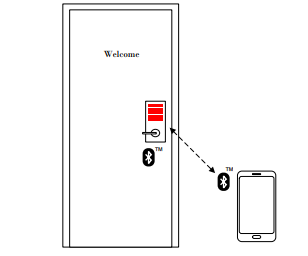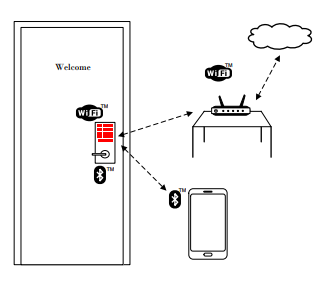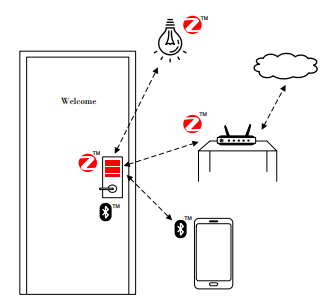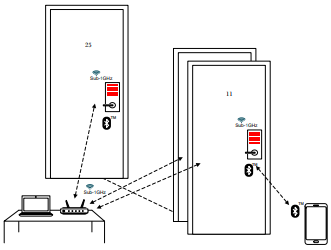SSZT625 september 2018 CC1314R10 , CC1352P , CC1352R , CC1354P10 , CC1354R10 , CC2640R2F , CC2642R , CC2652P , CC3220S , CC3230S , CC3235S
My home is filled with a group of connected devices that work seamlessly together to remind me of appointments, monitor my home security from afar, and allow me to turn off devices remotely when I’m leaving home in a rush. Security, privacy and robust connectivity are now achievable in a wide range of wireless applications, all of which empower us to create smart buildings that save us time, keep us safe and add convenience to our lives.
Smart door locks are one such application, and different wireless protocols have distinct advantages that you can use to tailor your product to the needs of the consumer. If you’re working on an electronic smart lock (e-lock), creating a successful product means having the flexibility to choose the most suitable wireless protocol and leave room for future-proofing.
With the SimpleLink™ platform of wireless microcontrollers (MCUs), you can add connectivity to your electronic door applications regardless of the wireless protocol you’ve selected. Here are four different types of smart lock designs supported by SimpleLink MCUs that use different wireless standards.
A Bluetooth® Low Energy Smart Lock with Low-power Smartphone Connectivity
Designers are increasingly abandoning physical keys for locking and unlocking and having consumers use their smartphones instead. This is possible through Bluetooth low energy, a capability of Bluetooth 5 that’s already available on most mobile devices. Once the consumer is close enough to the e-lock, they can unlock the door using their phone – no more fumbling with keys.
Such conveniences don’t make much sense if consumers have to change the e-lock’s batteries every week. The SimpleLink CC2640R2F MCU enables ultra-low power Bluetooth low energy operation with an average 1.1µA of sleep current thanks to its unique sensor controller, armed with its own random access memory (RAM) to help optimize power consumption. The sensor controller saves power by allowing the main Arm® Cortex®-M4F MCU core to sleep while waiting for user input via connected sensors, only waking up the main MCU core when necessary. The CC2642R is a pin-to-pin compatible Bluetooth low energy MCU also equipped with a sensor controller, but with an additional 224KB of additional flash memory.
 Figure 1 A Smart Door Lock Utilizing Bluetooth Low Energy
Figure 1 A Smart Door Lock Utilizing Bluetooth Low EnergyA Wi-Fi® Smart Lock with Cloud Connectivity
 Figure 2 A Wi-fi Smart Lock with Cloud and Bluetooth Connectivity
Figure 2 A Wi-fi Smart Lock with Cloud and Bluetooth ConnectivityA Zigbee® Smart Lock with Multiecosystem Connectivity
This type of solution uses a low-power Zigbee network connected to a smart home hub. The e-lock is integrated into a Zigbee mesh network along with light bulbs, thermostats and other smart devices in the home. Zigbee-based smart locks can connect to the cloud via a Zigbee hub, and users can control them remotely.
Zigbee networks are ultra low power, enabling multiyear battery operation on a coin-cell battery. These networks often use Bluetooth low energy to incorporate direct control from a smartphone. In order to operate successfully, Zigbee networks must perform well over long distances and environments with great interference.
The SimpleLink CC2652P ultra-low-power wireless MCU with integrated power amplifier enables long-range communications within a building network, boosting signals with up to 20dBm of output power while consuming only 85mA.
 Figure 3 A Smart Door Lock Utilizing Zigbee and BLE for Multiecosystem Connectivity
Figure 3 A Smart Door Lock Utilizing Zigbee and BLE for Multiecosystem ConnectivityA Sub-1 GHz Smart Lock for a Long-range Solution
A Sub-1 GHz implementation is best suited for commercial environments such as hotels or large office spaces. Sub-1 GHz technology is long range, so all doors in the building can connect to a single hub for central control. Sub-1 GHz networks can also use Bluetooth low energy to enable control of the entire network directly from a smartphone.
In this type of network, a system administrator can configure credentials from a remote location or lock and unlock all doors in the state of an emergency. It’s possible to add concurrent multiprotocol operation to your e-lock designs with the CC1352R, which has a dynamic multiprotocol manager (DMM) that enables you to tailor multiprotocol scheduling to your solution’s needs. In case a designer needs more output power, the CC1352P can provide +20dBm while maintaining low-power consumption.
 Figure 4 A Sub-1 GHz Long Range Smart Lock Solution with Bluetooth Low Energy for Smart Phone Connectivity
Figure 4 A Sub-1 GHz Long Range Smart Lock Solution with Bluetooth Low Energy for Smart Phone ConnectivityRegardless of the type of e-lock application, SimpleLink MCUs have the necessary hardware and software building blocks. Learn more about SimpleLink MCUs and explore the portfolio of connectivity technologies, unified by 100% code portability and low-power performance.
Additional Resources
Bluetooth:
- Reference design - Access control panel with Bluetooth Low Energy and capacitive touch
- App note - Smart door lock with SimpleLink platform
- Case study - TI Bluetooth Low Energy technology helps unlock the SchlageSense ™ smart deadbolt from Allegion
- Video - Bluetooth connected electronic door lock demo